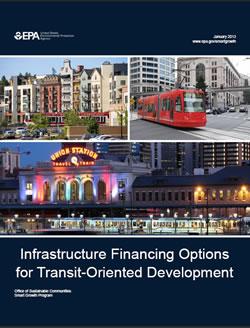
Transit-oriented development (TOD) is development near a transit station that offers a mix of housing, employment, shopping, and transportation choices. Putting homes, jobs, and stores close to transit can give people less expensive, less polluting transportation options while improving their access to more job opportunities throughout the region.
TOD is generally compact development, which uses land more efficiently and can help preserve undeveloped land, which can protect water quality. Yet the infrastructure required to create TOD is expensive, and funding for infrastructure for new TOD can be difficult to obtain.
Infrastructure Financing Options for Transit-Oriented Development (2013) gives communities a comprehensive guide of tools and strategies for financing and funding for TOD infrastructure. It includes examples of how some communities are using specific tools for individual infrastructure components, as well as strategies for combining and bundling tools to create plans that address construction phasing and market growth over time.
This report focuses on four areas related to infrastructure finance for TOD. The report:
- Identifies dozens of financing mechanisms and strategies that communities can use.
- Showcases how 11 communities are using finance tools and funding sources to implement TOD.
- Introduces four innovative models communities could consider for their TOD planning.
- Explains how community context and market factors affect the types of financing tools or funding strategies that communities can use.
EPA created this report through its Smart Growth Implementation Assistance Program. Four applicants – Cobb County and the Cumberland Community Improvement District, Georgia; the South Suburban Mayors and Managers Association, Illinois; the Utah Transit Authority, Salt Lake City, and Sandy City, Utah; and the city of Wheat Ridge, Colorado – requested assistance from EPA on funding and financing infrastructure to support TOD. EPA and its contractor team used their work in these communities to develop this publication.
Learn more about transit-oriented development on our Smart Growth and Transportation page.
You may need a PDF reader to view some of the files on this page. See EPA’s About PDF page to learn more.